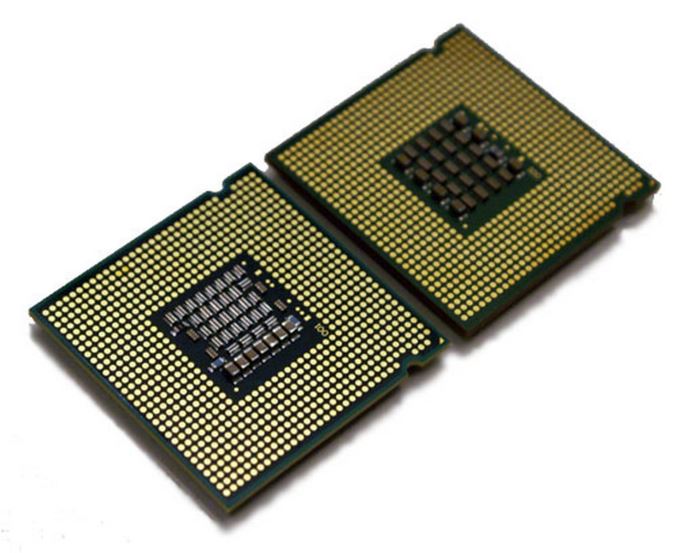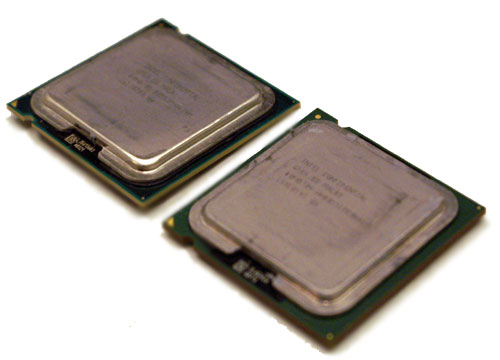Ten Year Anniversary of Core 2 Duo and Conroe: Moore’s Law is Dead, Long Live Moore’s Law
by Ian Cutress on July 27, 2016 10:30 AM EST- Posted in
- CPUs
- Intel
- Core 2 Duo
- Conroe
- ITRS
- Nostalgia
- Time To Upgrade

Today marks a full 10 years since the first Core 2 Duo processors, and hence Intel’s 64-bit Core microarchitecture, were made officially available at retail. These included a number of popular dual-core processor parts, including the seemingly ubiquitous E6400 and the Core 2 Extreme X6800. These were built on Intel’s 65nm process, and marked a turning point in the desktop processor ecosystem. To quote Anand in our launch review: ‘you’re looking at the most impressive piece of silicon the world has ever seen’.
Ten Year Anniversary of Core 2 Duo and Conroe
As part of this piece we will also look at some of the predictions for the future, from the latest (and possibly last) International Technology Roadmap for Semiconductors report, which predicts the stalling of smaller silicon manufacturing nodes over the next 10-15 years.
The first part of this article borrows heavily from Johan’s original look into the Intel Core microarchitecture back in 2006. It’s an awesome read.
Back When I Were A Lad
For a number of our readers, the launch of Conroe was a vast change in the processing landscape. The family of Netburst, Northwood and Prescott processors, in the form of Pentium D and Pentium 4, showed that pursuing the frequency race pushed the silicon far outside its efficiency zone and left a hot, power hungry mess in its wake. It didn’t even come with a muscular V8 sound, and AMD’s Athlon 64 X2 line had taken both the performance and efficiency crown.

Core 2 Duo (left) vs Pentium D (right)
From the perspective of Intel, it had to incorporate a significant paradigm shift in the way it approached the core microarchitecture – no more long pipelines to bump up clock rates to start. The Core microarchitecture design was marketed as a blend of Pentium Pro and Pentium M techniques, as well as the Netburst architecture, however as Johan pointed out at the time, it is significantly Pentium M and it is very hard to find anything Netburst in there. It wasn’t as simple as ‘adding a few functional units or decoders on Yonah and calling it a day’, almost 80% of the architecture and circuit design had to be redone.
As part of this piece, we’re going to take another look at the original architecture improvements of the Core microarchitecture design and some of our old performance metrics from a decade ago.
27th July 2006: Core 2 Launch Day
Ten years ago, Intel launched the following five processors:
| CPU | Clock Speed | L2 Cache |
| Intel Core 2 Extreme X6800 | 2.93GHz | 4MB |
| Intel Core 2 Duo E6700 | 2.66GHz | 4MB |
| Intel Core 2 Duo E6600 | 2.40GHz | 4MB |
| Intel Core 2 Duo E6400 | 2.13GHz | 2MB |
| Intel Core 2 Duo E6300 | 1.86GHz | 2MB |
The X6800 sits at the top with a higher clock speed with a higher supported FSB-to-core ration than previous Intel processors. The Core 2 processors all came from a 143mm2 die, compared the 162mm2 of Pentium D, and they both seem tiny by comparison to the large die sizes we see 2016 for things like the P100. These were chips without integrated graphics either. The introduction of Core 2 pushed the prices of the Pentium D processors down, to give this interesting table:
| CPU | Clock Speed | L2 Cache | Price |
| Intel Core 2 Extreme X6800 | 2.93GHz | 4MB | $999 |
| Intel Core 2 Duo E6700 | 2.66GHz | 4MB | $530 |
| Intel Core 2 Duo E6600 | 2.40GHz | 4MB | $316 |
| Intel Core 2 Duo E6400 | 2.13GHz | 2MB | $224 |
| Intel Core 2 Duo E6300 | 1.86GHz | 2MB | $183 |
| Intel Pentium D 945 | 3.40GHz | 2MBx2 | $163 |
| Intel Pentium D 915 | 2.80GHz | 2MBx2 | $133 |
| Intel Pentium D 820 | 2.80GHz | 1MBx2 | $113 |
| Intel Pentium D 805 | 2.66GHz | 1MBx2 | $93 |
Comparing this to recent Intel processors, and the X8600 matches the list price of the Core i7-5960X (an 8-core part), whereas the popular Core 2 Duo E6400 at $224 at the same price as the Core i5-6600.
A few years ago, I salvaged a super old computer of mine with an E6400 and took it for a spin for a pipeline piece entitled ‘Dragging Core 2 Duo into 2013’. We know that a number of users today are still using the old platform as their day to day machine, and given that it is now celebrating its 10th birthday, it is interesting that anyone wanting to play around with the old hardware can get a motherboard, memory and CPU from eBay for $50-70.
My crusty C2D Setup from 2013











158 Comments
View All Comments
bcronce - Wednesday, July 27, 2016 - link
My AMD 2500+XP lasted me until a Nahalem i7 2.66ghz. It was a slight.... upgradeartk2219 - Friday, July 29, 2016 - link
Very minor, im sure you barely noticed :).jjpcat@hotmail.com - Wednesday, July 27, 2016 - link
I have a Q6600 in my household and it's still running well.In term on performance, E6400 is about the same as the CPUs (e.g. z3735f/z3745f) used in nearly all cloudbook these days.
Michael Bay - Thursday, July 28, 2016 - link
Yep, I was surprised at that when looking through the benchmarks. Turns out Atom is not so slow after all.stardude82 - Wednesday, July 27, 2016 - link
I've just finished decommissioning all my Core 2 Duo parts, several of which have been upgraded with 2nd hand Sandy Bridge components.Yeah, CPU performance has been relatively stagnant. CPUs have come to where commercial jets are now in their technological development. Jets now fly slower than they did the 1960s, but have much better fuel economy per seat.
Not noted in the E6400 v. i5-6600 comparison is that they both have the same TDP which is pretty impressive. Also, you've got to take inflation into account which would bring the CPU price up to $256 or there about, enough for a i5-6600K.
ScottAD - Wednesday, July 27, 2016 - link
One could argue that while Core put Intel on top of the heap again, Sandy Bridge was a more important shift in design and as a result, many users went from Conroe to Sandy Bridge and have stayed there.That pretty much defines my PC currently. Haven't needed to upgrade. Crazy a decade like nothing.
ianmills - Wednesday, July 27, 2016 - link
When a website has trouble keeping up with current content and instead recycles decades old content.... things that make you go hmm...Ian Cutress - Wednesday, July 27, 2016 - link
I'm the CPU editor, we've been up to date for every major CPU launch for the last couple of years, sourcing units that Intel haven't sourced other websites and have done comprehensive and extensive reviews of every leading x86 development. We have had every Haswell-K (2), Haswell-E(3) Broadwell (2), Broadwell E3 Xeon (3), Broadwell-E (4) and Skylake-K (2) CPU tested and reviewed on each official day of launch. We have covered Kaveri and Carrizo in deep repeated detail over the last few years as well.This is an important chip and today marks in an important milestone.
Hmm...?
smilingcrow - Wednesday, July 27, 2016 - link
Ananand do CPUs very well, can't think of anyone better. Kudos and thanks to you 'guys'."This primarily leaves ARM (who was recently acquired by Softbank)"
They are under offer so not guaranteed to go through and ARM isn't a person. :)
ianmills - Wednesday, July 27, 2016 - link
I agree you do a good job with CPU's. Its some of the other topics that this site has been slowed down in when compared to previous years